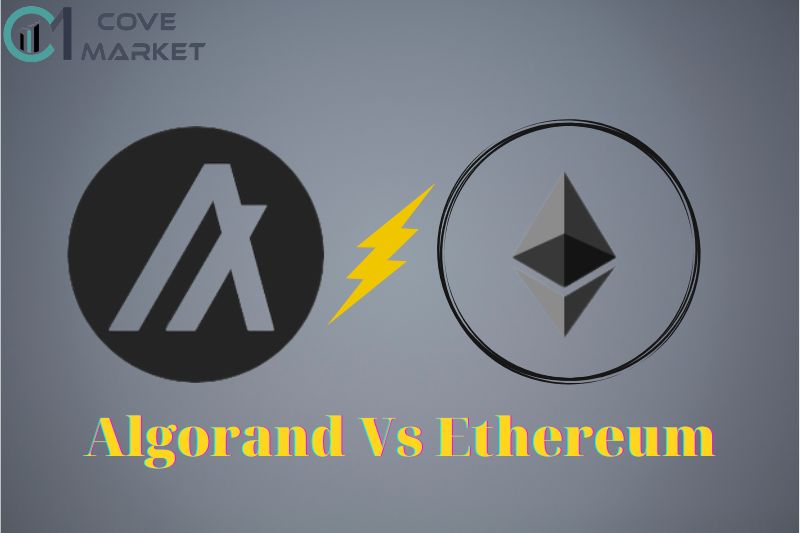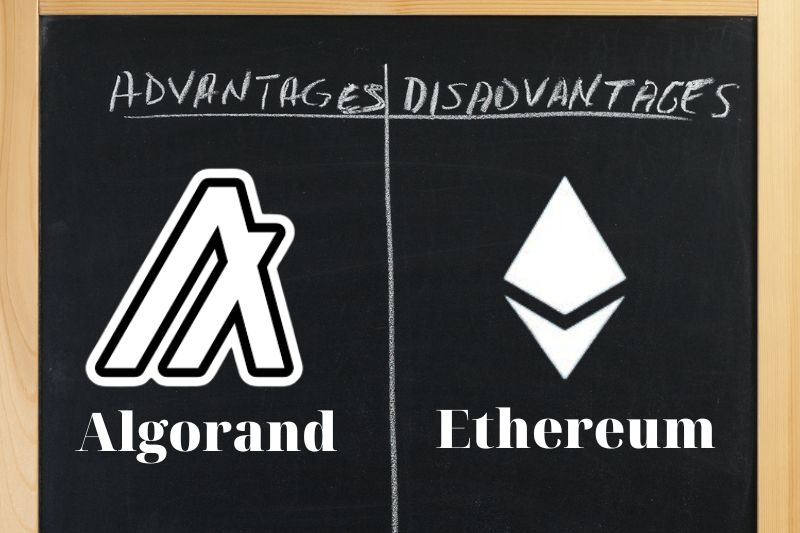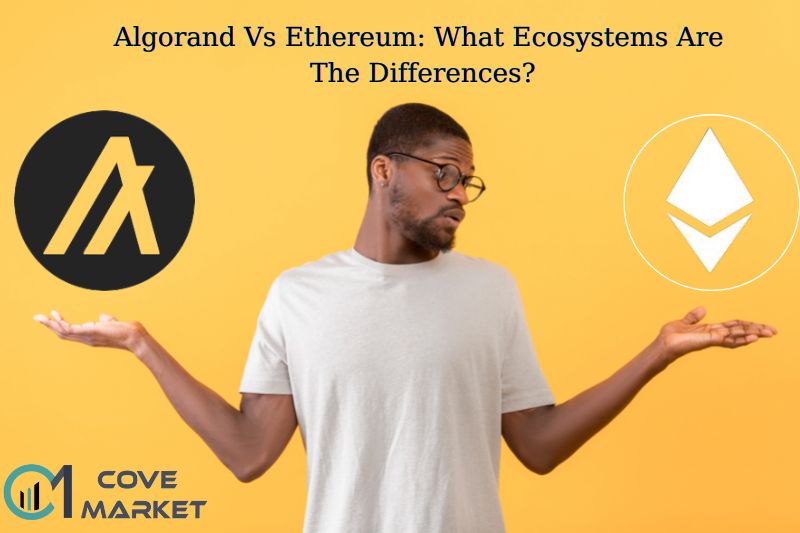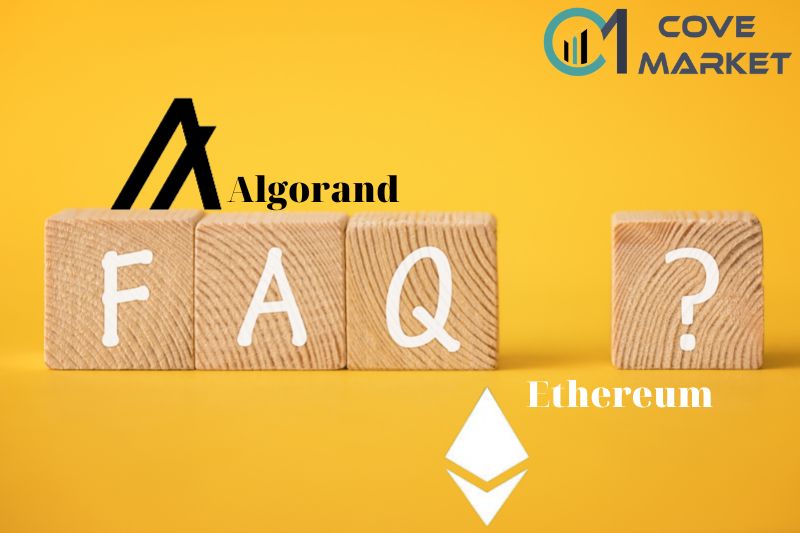If you’re wondering which cryptocurrency will come out on top in 2023, Algorand vs Ethereum are two hot coins in the cryptocurrency market. Check out this blog post to see which one is better positioned for you to invest.
Overview
Two ecosystems Algorand and Ethereum are “storming” the crypto market. So how are they similar and different, what are their advantages and disadvantages that make investors so excited.
In the following article, Covemarkets will carefully compare the differences between the two ecosystems Algorand and Ethereum. To find out which ecosystem is suitable to invest in this 2023!

What Is a Crypto Ecosystem?
A crypto ecosystem is a group of processes and functions that all have to do with cryptography. Each participant wants to do or get something out of the different things that keep the crypto environment active and alive.
Blockchain protocols and developers, miners and stakers, crypto exchanges, investors, and crypto media are some of the essential parts of the crypto ecosystem.
The blockchain ecosystem can give daily business activities genuine decentralization, immutability, transparency, accountability, and flexibility.
What is Algorand (ALGO)?
Algorand is a decentralized network built to solve the Blockchain Trilemma of achieving speed, security, and decentralization simultaneously.
Algorand, a permissionless, open-source blockchain network on which anybody may build, was introduced in June 2019 by computer scientist and MIT professor Silvio Micali.
What is Ethereum (ETH)?
Ethereum is a blockchain-based decentralized global software platform at its heart. It is most commonly known for its native cryptocurrency, ether, or ETH.
Scalable, programmable, secure, and decentralized are all features of Ethereum. It is the blockchain of choice for businesses and developers who are building technologies on top of it to transform several sectors.

Advantages vs. Disadvantages
Algorand
| Advantages | Disadvantages |
|
|
Ethereum
| Advantages | Disadvantages |
|
|
What Do They Have in Common?
- Both platforms are decentralized and permissionless, meaning that anyone can develop on them and there is no need for approval from a central authority.
- Both platforms use proof-of-stake consensus mechanisms, which are more energy-efficient than proof-of-work mechanisms like Bitcoin’s.
- Both platforms support smart contracts, which allow developers to build decentralized applications.

Algorand Vs Ethereum: What Ecosystems Are The Differences?
In the following article, Covemarkets will carefully compare the differences between the two ecosystems Algorand and Ethereum. To find out what they are different.
Mechanism
Algorand
Algorand is a blockchain platform that is powered by a consensus protocol. The platform offers a decentralized ledger that is tamper-proof and transparent. The consensus protocol is based on the idea of Byzantine Fault Tolerance.
Algorand uses a Byzantine agreement protocol to ensure that all nodes on the network agree on the state of the blockchain. This means that the network can tolerate up to ⅓ of its nodes being malicious or faulty. The platform uses a Proof-of-Stake algorithm that is designed to be scalable and secure. The Algorand network is designed to be energy-efficient and can handle large volumes of transactions.
Ethereum
The Ethereum blockchain uses a system called Gas for transaction fees. This system is similar to Bitcoin’s fee structure, but with some key differences. Gas is a unit of measurement that is used to determine the amount of computational effort that is required to execute a transaction or contract. The higher the gas price, the more computational effort is required, and the more expensive the transaction will be.
Ethereum’s gas prices are dynamic and are determined by the network itself. The gas price is set by the miners, who are incentivized to set it at a level that is high enough to cover their costs, but low enough to attract users.
When a user sends a transaction, they specify a gas price that they are willing to pay. If the transaction is included in a block, the miner who mines the block will receive the gas price as a reward. If the gas price is too low, the transaction may not be included in a block, and the user will have to resend it with a higher gas price.
Programming language
- Algorand is a cryptocurrency and smart contract platform that uses the Algorand Standard Assets (ASA) token. The programming language of Algorand is JavaScript.
- Ethereum is a programmable blockchain. It allows users to create their own decentralized applications and smart contracts. The programming language of Ethereum is Solidity.
Technology
Algorand
- Algorand uses a unique consensus algorithm that is designed to be secure, scalable, and fast. The Algorand Foundation, a non-profit organization, oversees the development of the Algorand protocol.
- The Algorand protocol is based on a novel consensus algorithm called Pure PoS (Proof of Stake). Pure PoS is a variant of the classic PoS (Proof of Stake) algorithm that does not require any special hardware or infrastructure. Pure PoS is also more energy efficient than PoW (Proof of Work) algorithms.
- Algorand uses a Byzantine Agreement Protocol (BAP) to reach consensus. BAP is a type of distributed ledger protocol that is resistant to Byzantine faults. Byzantine Agreement Protocols are known for their ability to achieve consensus in the presence of malicious actors.
- The Algorand network is composed of a set of nodes that run the Algorand software. Each node has a copy of the Algorand blockchain. Nodes can be operated by anyone. There is no need for special hardware or infrastructure.
Ethereum
- The technology of Ethereum is very different from other virtual currencies. The main difference is the use of smart contracts. A smart contract is a computer protocol that allows the exchange of digital assets between two parties without the intervention of a third party.
- Ethereum uses the blockchain technology to store and manage the smart contracts. The blockchain is a distributed database that stores all the transactions made on the network. It is a public ledger that can be verified by anyone.
- Ethereum is built on the Ethereum Virtual Machine (EVM), which is a decentralized network of computers that can run smart contracts. It executes the smart contracts and stores the results on the blockchain.
Decentralization
Algorand
Decentralization is a key principle of the Algorand network. It is intended to ensure that no single entity can control the network or interfere with its operation. To achieve this, the network is designed to be highly resistant to Sybil attacks, which is a type of attack in which an attacker creates multiple identities in order to gain undue influence over a network.
The Algorand network is also designed to be permissionless, meaning that anyone can participate in it without needing to obtain approval from any central authority. This allows for a truly decentralized network that is not controlled by any single entity.
Ethereum
The decentralization of Ethereum is a process that is underway to transition the management of the Ethereum network from the Ethereum Foundation to a decentralized governance model. The goal of this process is to create a more decentralized and resilient network that is less reliant on any one organization or individual for its continued operation.

Downtimes
Algorand
Algorand does not have any downtime. It is a decentralized platform, which means that it does not rely on any single entity. This makes it extremely robust and scalable. Algorand is also constantly being upgraded by the team of developers, which ensures that the platform is always up-to-date with the latest technology.
Ethereum
The Ethereum network has experienced several significant downtimes since its launch.
- In 2016, the DAO hack led to a hard fork of the Ethereum blockchain. This resulted in the creation of Ethereum Classic (ETC).
- In 2018, the Parity hack led to a loss of $152 million worth of ETH. This was followed by a number of other hacks, including the Coincheck hack which saw $534 million worth of NEM stolen. As a result of these hacks, and the general volatility of the cryptocurrency market, the price of ETH has fluctuated significantly. It reached an all-time high of over $1,400 in January 2018, before crashing to around $100 in September 2018.
- In September 2020, Ethereum suffered a minor network downtime in September 2020. The downtime was caused by a software upgrade that did not go as planned. The upgrade caused some nodes to go offline, which caused the network to stop functioning.
Transaction cost (Gas fees)
The cost of an Algorand transaction is calculated as follows:
- First, the size of the transaction in bytes is determined.
- Second, a fee is calculated based on the size of the transaction in bytes. The fee is currently set at 0.001 Algos per byte.
- Finally, the total cost of the transaction is the sum of the fees for all the bytes in the transaction.
Ethereum’s transaction cost is determined by the gas limit and gas price. The gas used depends on the complexity of the transaction. A simple transaction, such as sending ETH from one address to another, requires less gas than a complex transaction, such as deploying a smart contract.
Transaction speed
Algorand
With an average transaction time of 4.5 seconds per ALGO coin and almost instantaneous confirmation code generation, Algorand is outperforming its competitors. Up to 1300 TPS (transactions per second) may presently be processed by the ALgorrand system, and it is projected that this number will eventually approach 3000 TPS.
Ethereum
Ethereum’s transaction speed is a fast and secure blockchain platform that enables quick transactions with high fees (11.43 Gwei). Ethereum can process around 15 transactions per second.
Network size
Algorand
The size of the Algorand network is not publicly available. The Algorand network consists of a set of distributed ledger nodes that are each responsible for maintaining a local copy of the global ledger state. The network does not have a central authority or leader, and all nodes are equal. There is no minimum or maximum number of nodes required for the network to function, but more nodes increases security and stability. As of July 2020, there are 401,223 Algorand nodes in the world.
Ethereum
The Ethereum network is composed of all the nodes that are running the Ethereum protocol. There is no definitive answer to this question as the number of nodes is constantly changing. But until now the Ethereum network consists of over 25,000 nodes spread across the globe.

Scalability
Algorand
Algorand is designed to be scalable. It uses a new consensus algorithm, Proof of Stake Byzantine Agreement (PoSBA), which is more efficient than the current consensus algorithms used by other blockchains.
Algorand is also scalable in terms of the number of users it can support. The Algorand network can support millions of users. This is much higher than the number of users that can be supported by other blockchains. The Algorand network can store billions of pieces of data. This is much higher than the amount of data that can be stored on other blockchains.
Ethereum
Ethereum provides for a high level of scalability. The platform utilizes sharding, which is a process whereby the entire blockchain is split into multiple segments, each of which can be processed independently. This enables Ethereum to process a large number of transactions in a short period of time.
In addition, Ethereum employs a number of other techniques to improve scalability, including state channels and Plasma. State channels allow for off-chain transactions, which are not recorded on the blockchain. This reduces the load on the blockchain, and thus improves scalability.
Plasma is a system that allows for the creation of child chains, which are smaller versions of the main Ethereum blockchain. These child chains can be used to process transactions independently of the main chain, thus improving scalability.
The Ethereum team is also working on a number of other scalability solutions, such as sharding and Plasma. These solutions are still in development, and it remains to be seen how effective they will be. However, the fact that the Ethereum team is actively working on these solutions shows that they are committed to improving the scalability of the platform.
Market cap
| NAME | Algorand | Ethereum |
| Volume 24h | $79,378,256 | $8,811,584,029 |
| Price | $0.313 | $1,551.38 |
| Total Supply | 7,321,539,291 ALGO | 122,230,714 ETH |
| Market Cap | $2,159,921,503 | $189,596,878,824 |
DeFi ecosystem
Algorand
Algorand is a smart contract platform with a native token called ALGO. Algorand’s DeFi ecosystem includes a number of protocols, such as AlgoSar, AlgoSwap, and AlgoVerify.
- AlgoSar is a protocol that allows users to collateralize their ALGO tokens in order to borrow other assets.
- AlgoSwap is a protocol that allows users to trade ALGO tokens with other assets.
- AlgoVerify is a protocol that allows users to verify the authenticity of digital assets.
Ethereum
The Ethereum DeFi ecosystem includes a wide range of protocols and platforms that enable the creation of decentralized financial applications. These applications include lending and borrowing platforms, stablecoins, tokenized BTC platforms, and more. The most popular protocols in the Ethereum DeFi ecosystem are MakerDAO, Compound, and Synthetix.
- MakerDAO is a decentralized autonomous organization that creates and maintains the Dai stablecoin. The Dai stablecoin is pegged to the US Dollar and is backed by collateralized Ethereum tokens.
- Compound is a protocol that allows users to lend and borrow cryptocurrencies. It currently supports eight assets, including Ethereum, USDC, and DAI.
- Synthetix is a protocol that allows users to trade synthetic assets. Synthetic assets are digital assets that are backed by real-world assets.
NFTs
Algorand
The NFTs of Algorand are powered by the Algorand blockchain. They can be used to represent a wide range of digital assets, including but not limited to: Cryptocurrencies, Fiat currencies, Commodities, Tokens, Collectibles, Digital art, And more!
Algorand’s approach to NFTs allows for the creation of non-fungible tokens (NFTs) that are pegged to a piece of real-world property, with that property linked to the token. Algorand’s blockchain is secure and immutable, meaning that NFTs created on the platform are safe from tampering or theft. Algorand also can handle a large number of transactions per second, meaning that NFTs can be traded quickly and easily.
Ethereum
Ethereum was the first platform to implement NFTs. One of the most famous examples is CryptoKitties, a game that allows you to breed and collect virtual cats. Since then, Ethereum has become the blockchain of choice for NFTs. Over 95% of all NFT transactions take place on Ethereum.
The majority of NFTs have been created using Ethereum’s ERC-721 and ERC-1155 standards. The best-known examples of NFTs on Ethereum include digital collectibles such as CryptoKitties, Decentraland land parcels, Bored Ape Yacht Club (BAYC) and NBA Top Shot packs.
At a Glance
| Algorand | Ethereum | |
| Token Name | ALGO | Ethereum |
| Ticker | ALGO | ETH |
| Blockchain | Algorand Blockchain | Ethereum |
| Token type | Utility Token | Utility Token |
| Language | JavaScript | Solidly |
| Founders | Silvio Micali | Vitalik Buterin Gavin Wood |
Potential Projects
On Algorand
- The Marshall Islands project on Algorand: It is a partnership between the Marshall Islands and Algorand to create a digital currency for the Marshall Islands. The project is designed to help the Marshall Islands move away from its reliance on the US dollar, and to create a more efficient and secure financial system.
- The ARCC.one project on Algorand: It is a decentralized financial application called “ArccX”. The aim of ArccX is to allow users to hold, buy, sell and trade any digital asset (e.g. cryptocurrencies, fiat currencies, commodities, etc.) in a decentralized way. ArccX will be built on top of the Algorand blockchain and will use the Algorand Standard Assets (ASAs) to represent the different digital assets.
- The Yieldly project: It is a decentralized yield management protocol built on Algorand. The protocol enables users to stake their tokens in a pool and earn rewards based on the yield generated by the pool. The protocol also allows users to trade their tokens with other users in the pool.
On Ethereum
- Infinite Axie: As one of the most popular NFT games and a profitable coin, Axie Infinity is popular on the NFT market. Axie Infinity is a prominent Ethereum NFT project that enables participants to engage in a trading battle game in which they can train and cultivate Axies.
- Decentraland: Decentraland is an entirely three-dimensional online virtual realm. Since its introduction in 2020, the platform, which is based on the Ethereum blockchain, has made significant progress. The platform enables gamers to purchase land parcels with its native cryptocurrency token, MANA. Players can purchase land and explore Decentraland, and they have complete power over the platform using smart contracts.
- The Sandbox: The Sandbox is an additional well-known NFT project that is primarily recognized for its blockchain-based virtual environment and video game. It is a community-driven virtual metaverse game that enables the monetization of assets and gameplay on the blockchain network.
Algorand vs Ethereum: ALGO vs ETH – Which Is a Better Investment?
Algorand may be a better investment if you are looking for a more efficient and scalable blockchain. Ethereum may be a better investment if you are looking for a platform to build dApps or use smart contracts or looking for a platform with a large developer community and support from major companies.
Ultimately, the decision of which one to choose depends on your specific needs and preferences.
Where to buy ALGO and ETH?
You can buy ALGO and ETH on a variety of exchanges, including Binance, Coinbase, and Kraken.

FAQs
Which one should I choose?
Algorand and Ethereum are both excellent choices for cryptocurrency investment. They both have their own strengths and weaknesses. Algorand is faster and more scalable than Ethereum, but Ethereum has a more active development community. Ultimately, the decision of which one to choose depends on your specific needs and preferences.
Is Algorand more secure than Ethereum?
It is not possible to make a definitive statement about which blockchain is more secure, as both Algorand and Ethereum have different security mechanisms. However, it is worth noting that Algorand uses a proof-of-stake consensus algorithm, which is generally considered to be more secure than the proof-of-work algorithm used by Ethereum.
Which is more advanced?
Algorand is more advanced than Ethereum. It uses a pure proof-of-stake consensus algorithm, which is more efficient and scalable than Ethereum’s proof-of-work algorithm. Algorand also supports smart contracts and decentralized applications.
Is Algorand an Ethereum killer?
There is no clear answer to this question. While Algorand may offer some advantages over Ethereum, it is not clear if it is capable of completely replacing Ethereum.
Will Algorand be as big as Ethereum?
It is not possible to predict the future of a cryptocurrency, so it is not possible to say if Algorand will be as big as Ethereum.
Is Algorand or Ethereum more popular?
Ethereum is more popular than Algorand.
What are Ethereum Rollups?
Ethereum rollups are a type of scalability solution for the Ethereum blockchain. They work by aggregating multiple transactions into a single “rollup” transaction, which is then verified by a small number of nodes. This reduces the amount of data that needs to be processed and stored on the Ethereum blockchain, and thus allows for faster and cheaper transactions.
Conclusion
There is no clear winner when comparing Algorand and Ethereum. Both projects have their own strengths and weaknesses.
Algorand might be a better choice for investors who are looking for a more efficient and scalable platform. Ethereum might be a better choice for investors who are looking for a more established and well-known platform.
Hopefully, after this article you can find the right ecosystem for yourself. But first, you must study the market thoroughly before deciding to invest to minimize risk.

